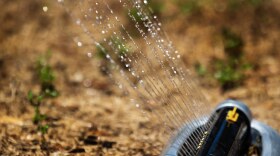Austin loses an estimated 21 gallons of water per person every day, mostly through leaks in the city's water distribution system. Last year that totaled 8.6 billion gallons lost. Those leaks waste more than water; they drain energy and cost money.
But there could be a small silver lining to the big problem of leaks: They appear to be drought-proofing some city trees.
That’s the finding of a team of UT researchers who recently took a look at the rings in trees close to leaky city infrastructure versus trees farther away. The group, headed by Jay Banner, looked specifically at trees along Waller Creek on the UT campus. Banner directs UT’s Environmental Science Institute.
Through isotope testing, Banner determined many local Austin creeks owe much of their flow to water from leaky pipes. He found that 25% to 50% of the water in Waller Creek, which flows through the UT campus and downtown Austin, appears to come from such leaks.
“Because of our initial study, we hypothesized that the trees in the urban watersheds, because of all this leakage, probably wouldn’t be as sensitive to climate changes such as droughts,” Banner told KUT.
The group then took nondamaging core samples of these trees to measure how they had grown through the years by looking at their rings.
“When there’s a drought, the trees don’t grow as fast, so they grow skinnier rings,” Banner said. “So we can use trees as sort of an indicator of past droughts.”
They then compared those samples with core samples from trees in Onion Creek, farther away from the city. What they found appears to confirm their hypothesis.
“The trees in the urban watershed were much less sensitive to drought than the rural watershed trees,” Banner said. “It’s actually a positive consequence of urbanization.”
Does that mean leaks are a good thing?
“Not hardly,” he said.
But he does believe the research could help city planners and water system engineers as they contend with urbanization.
“We know with continued increase in our state’s population there’s going to be more of a demand for water, as well as a demand for places to live,” he said.
Study authors said the research could even give a clearer picture of how leaks form.
“Is this a metric by which we can track degrading urban infrastructure? Its timing? Its extent?” said study co-author Bryan Black, a professor at the University of Arizona’s Laboratory of Tree-Ring Research.
“We start seeing signatures of degradation being recorded in these trees that are time capsules of the environment that they experience,” he said.













